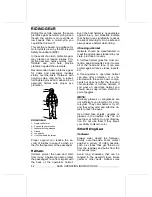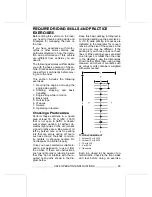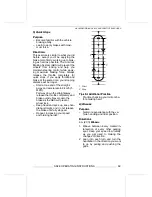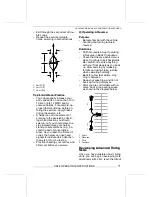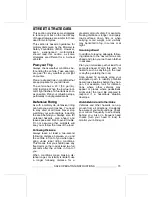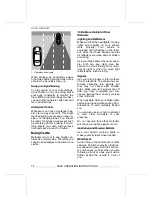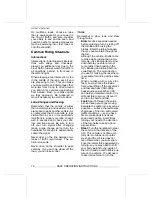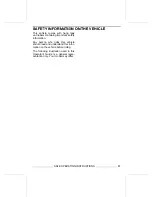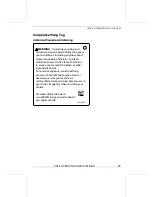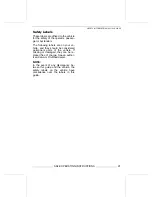
76
SAFE OPERATING INSTRUCTIONS
On multilane roads, choose a lane
that is appropriate for your speed in
the flow of traffic, and also consider
your ability to see and be seen, and
possible paths for evasive maneuvers
(such as swerving into other lanes or
onto the shoulder).
C
Co
om
mm
mo
on
n R
Riid
diin
ng
g S
Siittu
ua
attiio
on
nss
IIn
ntte
errsse
eccttiio
on
nss
Intersections, including small intersec-
tions
with
alleys
and
driveways,
present an additional risk due to the
cross traffic. Always watch for traffic in
all directions: behind, in front and to
the left and right.
When stopping at an intersection, stop
in the middle of the lane, even if you
are preparing to turn. This can make
you more visible and discourage other
motorists from trying to drive around
you. Watch for vehicles approaching
from behind. Flash your brake lights
as they approach. Be prepared to
move if necessary to avoid a collision.
L
La
an
ne
e C
Ch
ha
an
ng
ge
ess a
an
nd
d P
Pa
assssiin
ng
g
Remember that the vehicle is wider
than a motorcycle and needs more lat-
eral space to pass another vehicle. Al-
so remember that the vehicle is less
visible than a car, so it is particularly
important to signal your lane change
well in advance and check your mir-
rors and blind spots. Be sure to turn
off your turn signal after changing
lanes; a lane change will not turn the
handlebar far enough to automatically
cancel the signal.
Never drive on the line between two
lanes of traffic (split lanes). The ve-
hicle is too wide.
Never drive on the shoulder to pass
vehicles. If you put one wheel off the
road, you can lose control.
T
Tu
urrn
nss
Remember to slow, look, and steer
through turns.
–
S
Sllo
ow
w:: Reduce speed as needed
before entering a turn by rolling off
the throttle and/or using the
brakes. Enter the turn at a speed
that you can maintain throughout
the turn.
Although the vehicle is better able
to brake while turning than a mo-
torcycle, it is still important to slow
down before you enter a turn or
curve rather than braking in the
turn. Braking and turning both re-
quire traction. The more traction
you use for braking, the less there
is available for turning at the same
time.
When you take a turn or curve too
fast, you may notice the inside
front wheel lifting off the pavement
and feel and hear VSS cutting
back engine power. While VSS
can help you maintain control, it is
still possible to spin or roll over if
you turn too hard and fast.
–
L
Lo
oo
okk:: Search through the entire
turn and keep your eyes moving.
Evaluate the entire turn as soon as
possible — surface characteristics,
sharpness of the turn, and overall
traffic conditions — so you have
time to make decisions about
speed and position. Sometimes
turning your head in the direction
of the turn helps to keep a good
visual picture.
–
S
Stte
ee
err:: Turn the handlebar to steer
the vehicle in the direction of the
turn. This vehicle is not like a mo-
torcycle, so it does not counter-
steer, and the vehicle does not
lean. Remember, you will experi-
ence the lateral force generated by
turning, so you may need to shift
your body weight to the inside of
the turn to keep a comfortable pos-
ture on the vehicle. You will need
to exert more force to turn the
STREET STRATEGIES
Summary of Contents for RYKER 2023 Series
Page 10: ...8 This page is intentionally blank TABLE OF CONTENTS...
Page 11: ...9 G GE EN NE ER RA AL L I IN NF FO OR RM MA AT TI IO ON N...
Page 14: ...12 This page is intentionally blank GENERAL INFORMATION...
Page 15: ...13 G GE EN NE ER RA AL L P PR RE EC CA AU UT TI IO ON NS S...
Page 20: ...18 This page is intentionally blank ACCESSORIES AND MODIFICATIONS...
Page 21: ...19 V VE EH HI IC CL LE E I IN NF FO OR RM MA AT TI IO ON N...
Page 101: ...99 P PR RE E R RI ID DE E I IN NS SP PE EC CT TI IO ON N...
Page 104: ...102 This page is intentionally blank PRE RIDE CHECKLIST...
Page 105: ...103 M MA AI IN NT TE EN NA AN NC CE E...
Page 145: ...143 R RO OA AD D S SI ID DE E R RE EP PA AI IR RS S...
Page 160: ...158 This page is intentionally blank TRANSPORTING THE VEHICLE...
Page 161: ...159 T TE EC CH HN NI IC CA AL L I IN NF FO OR RM MA AT TI IO ON N...
Page 163: ...161 VEHICLE IDENTIFICATION...
Page 168: ...166 This page is intentionally blank EAC DECLARATION OF CONFORMITY...
Page 169: ...167 T TE EC CH HN NI IC CA AL L S SP PE EC CI IF FI IC CA AT TI IO ON NS S...
Page 179: ...177 W WA AR RR RA AN NT TY Y...
Page 201: ...199 C CU US ST TO OM ME ER R I IN NF FO OR RM MA AT TI IO ON N...
Page 206: ...204 CHANGE OF ADDRESS AND OWNERSHIP...
Page 207: ...205 This page is intentionally blank CHANGE OF ADDRESS AND OWNERSHIP...
Page 208: ...206 CHANGE OF ADDRESS AND OWNERSHIP...
Page 209: ...207 This page is intentionally blank CHANGE OF ADDRESS AND OWNERSHIP...
Page 210: ...208 NOTE CHANGE OF ADDRESS AND OWNERSHIP...
Page 211: ...209 NOTE CHANGE OF ADDRESS AND OWNERSHIP...
Page 212: ...210 NOTE CHANGE OF ADDRESS AND OWNERSHIP...
Page 213: ...211 NOTE CHANGE OF ADDRESS AND OWNERSHIP...
Page 214: ...212 NOTE CHANGE OF ADDRESS AND OWNERSHIP...
Page 215: ...213 NOTE CHANGE OF ADDRESS AND OWNERSHIP...
Page 216: ...214 NOTE CHANGE OF ADDRESS AND OWNERSHIP...
Page 217: ...215 NOTE CHANGE OF ADDRESS AND OWNERSHIP...
Page 218: ...216 NOTE CHANGE OF ADDRESS AND OWNERSHIP...
Page 219: ...217 NOTE CHANGE OF ADDRESS AND OWNERSHIP...
Page 220: ...218 Model No CHANGE OF ADDRESS AND OWNERSHIP...
Page 221: ......

